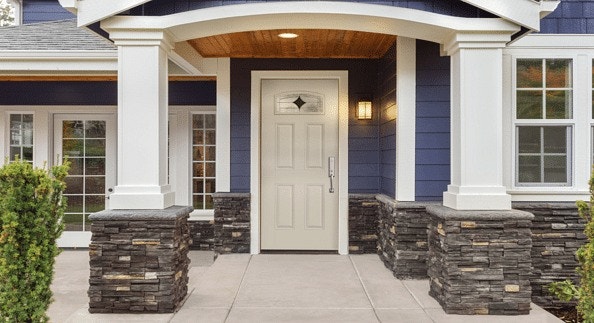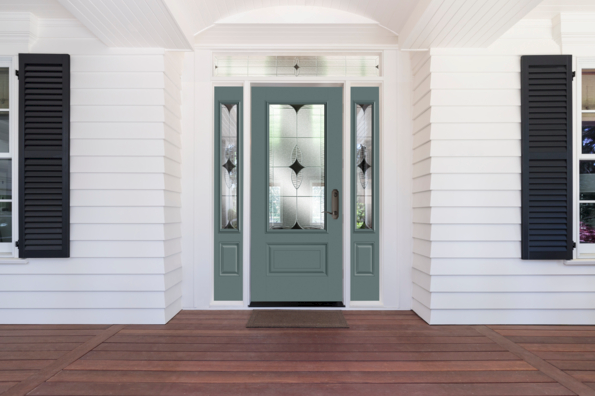Update Your Home with Elegant & Energy-Efficient Entry Doors
Posted
on March 10, 2020

Like many other products, innovations in technology, design and installation have increased energy efficiency for entry doors. Pella focuses on designing entry doors that can transform your curb appeal while improving the comfort of your home. Our elegant front doors are available in fiberglass and steel — each with their own qualities and characteristics. Read on to find out which energy-efficient front door is best for your home.
Energy-Efficient Exterior Doors
When purchasing a new or replacement front entry door, a top concern for most homeowners is energy-efficiency. There is a lot that goes into the design and building of energy-efficient front doors. Balance your curb appeal with energy-efficiency by ensuring you get the maximum front door insulation available. Continue reading for things to consider when you start shopping for a new or replacement entry door.
Placement of Your Entry Door
If your entry door faces constant, brutal summer sun or relentless winter gales, then insulation properties become a bigger concern than if the door will be more protected from the hot and cold weather. An entry door that is experiencing more of the harsh conditions from Mother Nature will need to have the ability to withstand more extreme temperatures in order to continue to keep your home comfortable year-round.
Tip: For front doors exposed to constant elements, consider a fiberglass entry door. A solid door can offer maximum front door insulation and fiberglass is a resilient material that stands up well to weather.

Front Entry Door Materials
Pella creates entry doors made of fiberglass or steel, all of which meet or exceed ENERGY STAR® certification in all 50 states.* Our entry doors are built to be highly durable.
Fiberglass entry doors are built to be exceptionally strong and low maintenance. Fiberglass doors are more resistant to dents and they can be stained to look just like a wood entry door. Steel entry doors are common amongst many homeowners. Their surface can be painted to change up your curb appeal, and they are easy to maintain.
Entry Door Frame Material
Each front entry door type has its own unique characteristics and benefits. Frames made of fiberglass composite materials are excellent insulators because they resist conducting heat and cold into your home. Fiberglass doors are durable and requires less maintenance.
Aluminum frames are inexpensive and durable, but they offer poorer insulation factors because they more readily conduct heat and cold than fiberglass.
Energy-Efficient Glass Options
Some homeowners choose elegant front doors with glass inserts to enhance the appearance and function, although large panes of glass within the door may reduce the door’s energy-efficiency compared to the same door without glass. The good news is Pella offers energy-efficient glass in their windows, and doors are no exception.
Dual-pane glass insulates almost twice as well as single-pane, while triple-pane glass provides additional energy efficiency. You can increase your door's energy efficiency by selecting Low-E (Low-Emissivity) glass coatings that reflect summer heat and winter cold and block harmful ultraviolet (UV) rays to help prevent fade damage.
Installing Energy-Efficient Entry Doors
Imprecise installation can negate some of the insulation benefits of the door and frame. That’s why Pella certified installers work to minimize the amount of energy that escapes around the outer edges of the door and frame. Choosing a Pella certified installer will help ensure your new or replacement front entry door is installed correctly and lead you to receive all the benefits of your new door. Plus, our installation comes with a worry-free installation plan which includes cleanup and removal of your old door.
Understanding How to Read Energy-Efficient Labels
One big part of shopping for a new or replacement front entry door is understanding how to read the energy-efficiency labels. For the greatest energy-saving potential, look for doors with these two labels:
- ENERGY STAR® certified. This designation means the government has certified that the product meets or exceeds energy performance standards in your state.
- The NFRC label. The National Fenestration Ratings Council (NFRC) is a nonprofit organization for the window industry that developed an energy rating system based on whole-unit product performance. It's the only reliable way to determine the entire door’s energy performance and compare products side-by-side.
- The NFRC label contains a U-Factor rating and a Solar Heat Gain Coefficient (SHGC) number. Preferred SHGC depends on the part of the country you are in. For instance, you would want a high SHGC in the far north.
- Look for a high R-value exterior door. The higher the R-value, the greater your entry door will be at insulating. This means your home will be able to stay comfortable throughout the seasons.
Understanding the benefits an elegant new or replacement entry door can bring to your home is the first step in the process. Stop by your nearest Pella showroom to speak to a Pella expert and learn what entry door options are right for you.
*Some Pella products may not meet ENERGY STAR® guidelines in Canada. For more information, contact your local Pella sales representative or go to energystar.gc.ca.
Schedule a free consultation to find windows and doors for your home.
